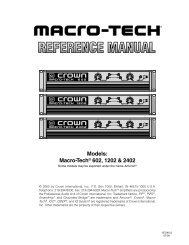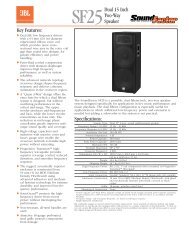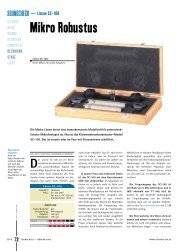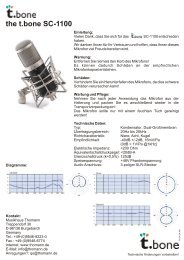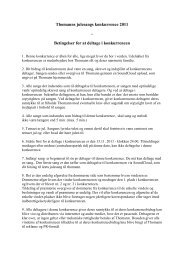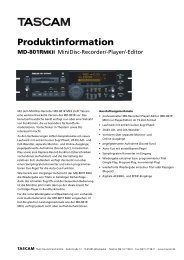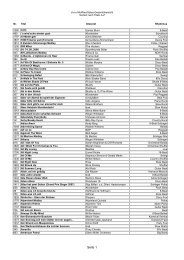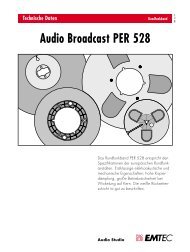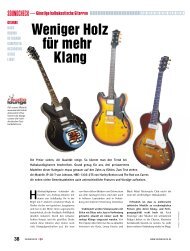Evolution UC16 USB MIDI Controller with 16 rotary programmable ...
Evolution UC16 USB MIDI Controller with 16 rotary programmable ...
Evolution UC16 USB MIDI Controller with 16 rotary programmable ...
Create successful ePaper yourself
Turn your PDF publications into a flip-book with our unique Google optimized e-Paper software.
<strong>Evolution</strong> <strong>UC<strong>16</strong></strong><br />
<strong>USB</strong> <strong>MIDI</strong> <strong>Controller</strong> <strong>with</strong> <strong>16</strong> <strong>rotary</strong> <strong>programmable</strong><br />
controllers, 25 Memory Banks and <strong>USB</strong><br />
WWW.EVOLUTION.CO.UK<br />
EVOLUTION <strong>UC<strong>16</strong></strong> <strong>USB</strong> <strong>MIDI</strong> CONTROLLER MANUAL
1. POWER SUPPLY<br />
There are two methods of powering the <strong>UC<strong>16</strong></strong>. Only use one method at one time<br />
AC Power<br />
You can also use an AC adapter (not included) <strong>with</strong> the following specification: 9-12V DC<br />
output, 250-300mA, centre positive.<br />
Connect to the <strong>USB</strong> port on your computer. The <strong>UC<strong>16</strong></strong> is powered from <strong>USB</strong>.<br />
Note: Do not leave the adapter plugged in for long periods of time if the unit is not in use.<br />
2. Preparation<br />
Connect the unit <strong>with</strong> other <strong>MIDI</strong> equipment you may have:<br />
The <strong>UC<strong>16</strong></strong> will act as a <strong>MIDI</strong> interface for any other <strong>MIDI</strong> equipment you may have. Note<br />
however, that it will only act as a <strong>MIDI</strong> THRU device. It will receive data from the <strong>USB</strong> port of<br />
the computer and pass this data on to the connected device. It can not transmit data from a<br />
connected device to the computer.<br />
Turn on the POWER switch.<br />
Turn all other equipment on.
3. Assignable Rotary controllers<br />
There are <strong>16</strong> assignable controllers selected by the CONTROL SELECT & CONTROL ASSIGN<br />
functions.<br />
‘Assignable <strong>Controller</strong>s’ refers to any of the <strong>16</strong> assignable Knobs.<br />
The basic operation is:-<br />
Select the controller by moving it. Alternatively, you can press the CONTROL SELECT button<br />
and then type in the number using the keypad or ‘+’, ‘-‘ buttons. Press the CONTROL ASSIGN<br />
button and enter the new number using the keypad.<br />
To change one of the assignable controllers, the <strong>UC<strong>16</strong></strong> uses the following method:<br />
Press the CONTROL SELECT button and release. Alternatively simply move the <strong>rotary</strong> control.<br />
The number of the presently selected <strong>MIDI</strong> controller will flash.<br />
Select a controller by moving any one of the assignable controllers, the numeric keypad or the<br />
+/- keys.<br />
The LED display will show the new <strong>MIDI</strong> controller number assignment.<br />
Repeat this process to see the controller number assignment (0-132) for any Knob (1-<strong>16</strong>), by<br />
moving the relevant controller or by typing a new number.<br />
If no keys are pressed or any of the assignable controllers moved, the LED display stops<br />
flashing after 3 seconds and returns to normal operation.<br />
Press the CONTROL ASSIGN button & release.<br />
The number entered at this point will be assigned to the last selected controller.<br />
The numeric entry uses the standard data entry system. (see section on Entering Numbers)<br />
If a complete number is entered the display stops flashing and the new assignment is stored.<br />
If the Inc/Dec keys are used, the revised value is shown on the LED display and the flashing<br />
time-out is reset.<br />
Once a controller has been assigned the current knob position should be sent out.<br />
This ensures that when the controller if first moved it does not trigger a large jump from it’s<br />
previous setting.<br />
During the data entry stage while the LED display is flashing, the Knobs, do not function.
4. Entering Numbers<br />
When any number is entered it adheres to the following rules:-<br />
Increment/Decrement Keys<br />
Initially the LED display starts flashing.<br />
The value displayed can be incremented/decremented using the +/- keys.<br />
Pressing both + & - should call up the default value for that parameter.<br />
The LED display shows the new value.<br />
The new value is sent out except for the CONTROL ASSIGN which sends data when the display<br />
stops flashing)<br />
When the display stops flashing the keyboard returns to normal operation.<br />
Numeric Keys<br />
Initially the LED display starts flashing.<br />
A numeric value can be typed in using the numbers 0-9.<br />
As each key is pressed the display continues to flash, the time-out value is reset.<br />
When a complete number* has been entered the display stops flashing and the value is<br />
selected.<br />
Alternatively, if no key is pressed and the display stops flashing the number on the display is<br />
selected.<br />
The update routine is triggered, so that the new value is sent out.<br />
When the display stops flashing the keyboard returns to normal operation.<br />
* The following table shows how many keys are required to enter a complete number:-<br />
1 key 2 keys 3 keys<br />
Channel 2-9 01,10-<strong>16</strong><br />
Memory 0-9<br />
Program Changes 13-99 000-012, 100-127<br />
Bank LSB/MSB 13-99 000-012, 100-127<br />
Control Select 2-9 01,10-14<br />
Control Assign 14-99 000-013, 100-132<br />
5. Snap Shot<br />
When both SNAP SHOT keys are pressed the UC-<strong>16</strong> sends out the settings for all of the<br />
Assignable <strong>Controller</strong>s. The settings will be sent out on whichever channel each <strong>rotary</strong> dial is<br />
assigned to (see channel assignment later). This feature lets you record the settings of the Knobs<br />
into your sequencer. It is handy for setting up parameters in a song. Set the <strong>UC<strong>16</strong></strong> to all<br />
parameter levels you desire, engage record mode on your sequencer and press the SNAP SHOT<br />
buttons.
6. Memory banks and Presets<br />
There are 25 memory banks in total. Memory banks 1-4 are accessible using the Preset buttons<br />
1-4 respectively. This allows you to store settings you use a lot and makes for easy access to<br />
them. By default the 4 presets are:<br />
1. Propellerhead’s Reason mixer<br />
2. Steinberg’s Halion sampler<br />
3. Native Instruments FM7<br />
4. General GM/GS/XG preset.<br />
The rest of the memory banks are accessible by pressing the RECALL button, then using either<br />
the +/- buttons or the numeric keys to type in the number of the memory bank you want (1-25). By<br />
default the remaining presets are:<br />
5. Native Instruments B4<br />
6. Native Instruments Pro-52<br />
7. Steinberg Model-E<br />
8. Waldorf Attack<br />
9. Waldorf PPG wave 2V<br />
10.Propellerhead's Rebirth Master<br />
11.Propellerhead's Rebirth Rhythm section<br />
12.Reason Subtractor<br />
13.Reason Dr. Rex<br />
14.Reason NN-19<br />
15.AAS Lounge Lizard<br />
<strong>16</strong>. Native Instruments Traktor DJ<br />
17.cc numbers 40 – 55.<br />
18.cc numbers 75 – 90<br />
19.cc numbers 102 – 117<br />
20.Volume (cc7) on channels 1 – <strong>16</strong><br />
21.Pan (cc7) on channels 1 – <strong>16</strong><br />
Bank numbers 22 – 25 have the same default as bank number 4.<br />
For a fully detailed list of the memory bank presets please look at the <strong>UC<strong>16</strong></strong> Memory bank<br />
definitions document bundled <strong>with</strong> your <strong>UC<strong>16</strong></strong>, or available to download from our website.<br />
It is also possible to store your own presets.<br />
To save the current settings for all <strong>16</strong> controllers press the MEMORY buttons (CHANNEL<br />
ASSIGN and RECALL), then type in the number of the memory bank you want (1-25).<br />
Alternatively, you can use the ‘+’ and ‘-‘ buttons.<br />
Each memory bank will store the current Program number and channel transmit number for all of<br />
the <strong>16</strong> controllers.<br />
If you make a mess of things, don’t worry – you can always get the factory presets back by<br />
holding down the ‘+’ and ‘-‘ keys on power up.
7. Setting the <strong>MIDI</strong> Transmit Channel<br />
The <strong>MIDI</strong> channel can be set for each <strong>rotary</strong> controller individually. To do this press the<br />
CHANNEL ASSIGN button. The channel the currently selected <strong>rotary</strong> dial is assigned to will flash<br />
on the LED display. For example, if the last selected dial is currently assigned to channel 1, the<br />
LED display will flash ‘c1’. Increment or decrement the channel using the numeric keypad, or the<br />
‘+’ and ‘-‘ buttons.<br />
8. <strong>MIDI</strong> OUT FROM <strong>USB</strong><br />
The <strong>MIDI</strong> output connector is normally used to send <strong>MIDI</strong> data from the <strong>UC<strong>16</strong></strong>. If the <strong>UC<strong>16</strong></strong> is<br />
connected to a computer using <strong>USB</strong> the <strong>MIDI</strong> Out can also be used to send data received from<br />
<strong>USB</strong>.<br />
Pressing both <strong>MIDI</strong> OUT FROM <strong>USB</strong> buttons flashes the current setting on the LCD display.<br />
The +/- keys can be used to alter the current setting. + selects YES, - selects NO.<br />
Pressing both + and - calls up the default setting which is NO.<br />
When ‘NO’ is selected the <strong>MIDI</strong> Out sends the data from the <strong>UC<strong>16</strong></strong>.<br />
When YES is selected the <strong>MIDI</strong> Out sends the <strong>MIDI</strong> data received from <strong>USB</strong>.<br />
The status of <strong>MIDI</strong> OUT FROM <strong>USB</strong> will be saved in non-volatile memory and restored when the<br />
<strong>UC<strong>16</strong></strong> is switched on again. The factory default is set to NO.<br />
9. SPECIFICATIONS<br />
1. Control: Switches: (CHANNEL ASSIGN, MEMORY, CONTROL ASSIGN, CONTROL SELECT,<br />
POWER ON/OFF, Numeric Keys (0-9), PRESET BUTTONS 1-4, + AND - KEYS)<br />
3. Rotary Controls: <strong>16</strong> <strong>rotary</strong> controls <strong>with</strong> assignable controller and channel values<br />
5. Memory storage - non volatile, 25 banks, 4 fast presets<br />
6. Display: 3 digit LED<br />
7. Jack: DC IN (DC 9V), <strong>MIDI</strong> OUT, <strong>USB</strong><br />
8. Dimension: 29.6cmX12.5cmX4.8cm<br />
9. Weight: 0.75Kg<br />
Note: Specifications are subject to change <strong>with</strong>out prior notice.
APPENDIX A<br />
<strong>MIDI</strong> IMPLEMENTATION CHART<br />
Function Transmitted Received Remarks<br />
Basic :Default Channel:Changed 1-<strong>16</strong> 1-<strong>16</strong><br />
:Default Mode :Messages :Altered --------- X *********<br />
Note Number:True Voice 0-127 *********<br />
Velocity: Note ON : Note OFF X X<br />
After :Key’s Touch :Ch’s X •<br />
Pitch Bend X<br />
0,32 1 Control 6 Change 7 • • • 0 0 Bank select Modulation Data<br />
64<br />
Entry Volume Hold 1<br />
1-31 33-95 102-121 • • • Mod Wheel Assign<br />
Program Change:True Number 0-127 *********<br />
System Exclusive X<br />
:Song Position Common:Song Select<br />
:Tune<br />
X X X<br />
System :Clock Exclusive:Commands X X<br />
Aux :Local ON/OFF Messages:All Notes<br />
OFF :Active Sense :Reset<br />
X X 0 X<br />
Notes: • : Can be set to 0 or X<br />
For support email support@evolution.co.uk<br />
Latest drivers and information at www.evolution.co.uk<br />
Join the <strong>Evolution</strong> User’s group at Yahoo groups, www.yahoogroups.com/group/evolution-users<br />
or e-mail to this address: evolution-users-subscribe@yahoogroups.com
APPENDIX B<br />
STANDARD CONTROLLER NUMBERS<br />
No. <strong>Controller</strong><br />
No. <strong>Controller</strong><br />
00 Bank Select 43 Expression LSB<br />
01 Modulation 44 <strong>Controller</strong> 44<br />
02 Breath Control 45 <strong>Controller</strong> 45<br />
03 <strong>Controller</strong> 3 46 <strong>Controller</strong> 46<br />
04 Foot Control 47 <strong>Controller</strong> 47<br />
05 Porta Time 48 Gen Purpose 1 LSB<br />
06 Data Entry<br />
49 Gen Purpose 2 LSB<br />
07 Channel Volume 50 Gen Purpose 3 LSB<br />
08 Balance<br />
51 Gen Purpose 4 LSB<br />
09 <strong>Controller</strong> 9 52 <strong>Controller</strong> 52<br />
10 Pan<br />
53 <strong>Controller</strong> 53<br />
11 Expression 54 <strong>Controller</strong> 54<br />
12 Effects <strong>Controller</strong> 1 55 <strong>Controller</strong> 55<br />
13 Effects <strong>Controller</strong> 2 56 <strong>Controller</strong> 56<br />
14 <strong>Controller</strong> 14 57 <strong>Controller</strong> 57<br />
15 <strong>Controller</strong> 15 58 <strong>Controller</strong> 58<br />
<strong>16</strong> Gen Purpose 1 59 <strong>Controller</strong> 59<br />
17 Gen Purpose 2 60 <strong>Controller</strong> 60<br />
18 Gen Purpose 3 61 <strong>Controller</strong> 61<br />
19 Gen Purpose 4 62 <strong>Controller</strong> 62<br />
20 <strong>Controller</strong> 20 63 <strong>Controller</strong> 63<br />
21 <strong>Controller</strong> 21 64 Sustain Pedal<br />
22 <strong>Controller</strong> 22 65 Portamento<br />
23 <strong>Controller</strong> 23 66 Sostenuto<br />
24 <strong>Controller</strong> 24 67 Soft Pedal<br />
25 <strong>Controller</strong> 25 68 Legato Pedal<br />
26 <strong>Controller</strong> 26 69 Hold 2<br />
27 <strong>Controller</strong> 27 70 Sound Variation<br />
28 <strong>Controller</strong> 28 71 Resonance<br />
29 <strong>Controller</strong> 29 72 Release Time<br />
30 <strong>Controller</strong> 30 73 Attack Time<br />
31 <strong>Controller</strong> 31 74 Cutoff Frequency<br />
32 Bank Select LSB 75 <strong>Controller</strong> 75<br />
33 Modulation LSB 76 <strong>Controller</strong> 76<br />
34 Breath Control LSB 77 <strong>Controller</strong> 77<br />
35 <strong>Controller</strong> 35 78 <strong>Controller</strong> 78<br />
36 Foot Control LSB 79 <strong>Controller</strong> 79<br />
37 Porta Time LSB 80 Gen Purpose 5<br />
38 Data Entry LSB 81 Gen Purpose 6<br />
39 Channel Volume LSB 82 Gen Purpose 7<br />
40 Balance LSB 83 Gen Purpose 8<br />
41 <strong>Controller</strong> 41 84 Portamento Control<br />
42 Pan LSB<br />
85 <strong>Controller</strong> 85<br />
No. <strong>Controller</strong><br />
86 <strong>Controller</strong> 86<br />
87 <strong>Controller</strong> 87<br />
88 <strong>Controller</strong> 88<br />
89 <strong>Controller</strong> 89<br />
90 <strong>Controller</strong> 90<br />
91 Reverb Depth<br />
92 Tremelo Depth<br />
93 Chorus Depth<br />
94 Celeste (De-tune)<br />
95 Phaser Depth<br />
96 Data Increment<br />
97 Data Decrement<br />
98 Non-Reg Param LSB<br />
99 Non-Reg Param MSB<br />
100 Reg Param LSB<br />
101 Reg Param MSB<br />
102 <strong>Controller</strong> 102<br />
103 <strong>Controller</strong> 103<br />
104 <strong>Controller</strong> 104<br />
105 <strong>Controller</strong> 105<br />
106 <strong>Controller</strong> 106<br />
107 <strong>Controller</strong> 107<br />
108 <strong>Controller</strong> 108<br />
109 <strong>Controller</strong> 109<br />
110 <strong>Controller</strong> 110<br />
111 <strong>Controller</strong> 111<br />
112 <strong>Controller</strong> 112<br />
113 <strong>Controller</strong> 113<br />
114 <strong>Controller</strong> 114<br />
115 <strong>Controller</strong> 115<br />
1<strong>16</strong> <strong>Controller</strong> 1<strong>16</strong><br />
117 <strong>Controller</strong> 117<br />
118 <strong>Controller</strong> 118<br />
119 <strong>Controller</strong> 119<br />
Channel Mode Messages<br />
120 All Sound off<br />
121 Reset all <strong>Controller</strong>s<br />
122 Local Control<br />
123 All Notes Off<br />
124 Omni Off<br />
125 Omni On<br />
126 Mono On (Poly Off)<br />
127 Poly On (Mono Off)



